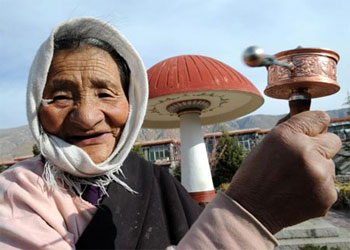Religions in Tibet

No other religion apart from Buddhism has been able to take root in Tibet. Only a small population of about 2,000 throughout Tibet have faith in Islam, while there is no trace of Christianity at all. The Bon, the aboriginal religion of Tibet, a sect of Shamanism which chiefly worshipped idols and the Nature and practiced driving off evil spirits, had at one time prevailed in Tibet but lost ground with the penetration of Buddhism.
Thus, Buddhism can as well be said to be the sole religion of Tibet, and the faith has taken so deep in root that it means almost everything to the Tibetans as already mentioned. Well-to-do families even built in their compound their private chapels of prayer-rooms. To begin with, the first Buddhist scripture printed in Sanskrit was said to have been descended from Heaven in the 5th century during the reign of 28th Tsanpo Tho-Tho-Ri Nyantsan. It was translated into Tibet, and later in the 8th century after the visit of the Indian Master Padmasambhava, the spread of Buddhism accelerated and religious sects started taking shape. In the 11th century the visit of the Bengali Master, Atisha, to Tibet greatly encouraged the study of Buddhism into Tibet and sowed the seed for Gelugpa, the greatest sect that was to come. Finally, in the 15th century, Tsongkapa, the great reformer of Tibetan Buddhism, came to Tibet from Qinghai and founded the Gelugpa sect, the Order of Excellence, and here after Buddhism went all-out spreading like a wild fire into Tibet and the absolute ruler both of the claret and the state is another decisive victory for Buddhism to rise to its paramount as the religion of the entire Tibetan nationality.
Find Your Travel Mate
to cut down the cost
Come in a group and get special discounted price.
You will be regularly updated if anyone join into the program that you are intrested in.
Click here
to Write us

